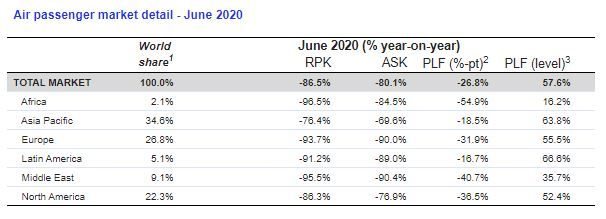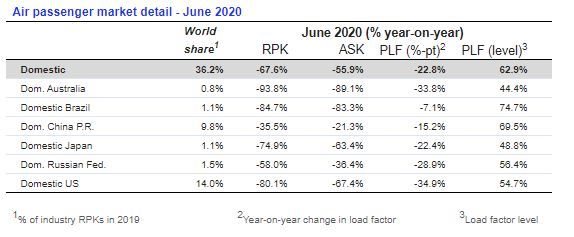
Subscribe & Follow
#AfricaMonth
Jobs
In the news
IATA: International travel recovery delayed as lockdown remains

It also expects short-haul (primarily domestic traffic) to recover to 2019 levels in 2023 and not 2022 as it had previously forecast. In the meantime, global passenger traffic during June 2020 remains 86.5% lower than in the same month in 2019.
In the below base case scenario below:
• Global passenger traffic (revenue passenger kilometers or RPKs) will not return to pre-Covid-19 levels until 2024, a year later than previously projected.
• The recovery in short haul travel is still expected to happen faster than for long haul travel. As a result, passenger numbers will recover faster than traffic measured in RPKs. Recovery to pre-Covid-19 levels, however, will also slide by a year from 2022 to 2023. For 2020, global passenger numbers (enplanements) are expected to decline by 55% compared to 2019, worsened from the April forecast of 46%.
June 2020 passenger traffic foreshadowed the slower-than-expected recovery. Traffic, measures in RPK, fell 86.5% compared to the year-ago period. That is only slightly improved from a 91.0% contraction in May. This was driven by rising demand in domestic markets, particularly China. The June load factor set an all-time low for the month at 57.6%.
The more pessimistic recovery outlook is based on a number of recent trends:
• Slow virus containment in the US and developing economies: Although developed economies outside of the US have been largely successful in containing the spread of the virus, renewed outbreaks have occurred in these economies, and in China.
Furthermore there is little sign of virus containment in many important emerging economies, which in combination with the US, represent around 40% of global air travel markets. Their continued closure, particularly to international travel, is a significant drag on recovery.
• Reduced corporate travel: Corporate travel budgets are expected to be very constrained as companies continue to be under financial pressure even as the economy improves. In addition, while historically GDP growth and air travel have been highly correlated, surveys suggest this link has weakened, particularly with regard to business travel, as video conferencing appears to have made significant inroads as a substitute for in-person meetings.
• Weak consumer confidence: While pent-up demand exists for VFR (visiting friends and relatives) and leisure travel, consumer confidence is weak in the face of concerns over job security and rising unemployment, as well as risks of catching Covid-19. Some 55% of respondents to IATA’s June passenger survey don’t plan to travel in 2020.
Owing to these factors, IATA’s revised baseline forecast is for global enplanements to fall 55% in 2020 compared to 2019 (the April forecast was for a 46% decline). Passenger numbers are expected to rise 62% in 2021 off the depressed 2020 base, but still will be down almost 30% compared to 2019. A full recovery to 2019 levels is not expected until 2023, one year later than previously forecast.
Meanwhile, since domestic markets are opening ahead of international markets, and because passengers appear to prefer short haul travel in the current environment, RPKs will recover more slowly, with passenger traffic expected to return to 2019 levels in 2024, one year later than previously forecast. Scientific advances in fighting Covid-19 including development of a successful vaccine, could allow a faster recovery. However, at present there appears to be more downside risk than upside to the baseline forecast.
"Passenger traffic hit bottom in April, but the strength of the upturn has been very weak. What improvement we have seen has been domestic flying. International markets remain largely closed. Consumer confidence is depressed and not helped by the UK’s weekend decision to impose a blanket quarantine on all travelers returning from Spain. And in many parts of the world infections are still rising. All of this points to a longer recovery period and more pain for the industry and the global economy," said Alexandre de Juniac, IATA’s Director General and CEO.
"For airlines, this is bad news that points to the need for governments to continue with relief measures—financial and otherwise. A full Northern Winter season waiver on the 80-20 use-it-or-lose it slot rule, for example, would provide critical relief to airlines in planning schedules amid unpredictable demand patterns. Airlines are planning their schedules. They need to keep sharply focused on meeting demand and not meeting slot rules that were never meant to accommodate the sharp fluctuations of a crisis. The earlier we know the slot rules the better, but we are still waiting for governments in key markets to confirm a waiver," said de Juniac.
June 2020 performance

International passenger markets
June international traffic shrank by 96.8% compared to June 2019, only slightly improved over a 98.3% decline in May, year-over-year. Capacity fell 93.2% and load factor contracted 44.7 percentage points to 38.9%.
Asia-Pacific airlines’ June traffic plummeted 97.1% compared to the year-ago period, little improved from the 98.1% decline in May. Capacity fell 93.4% and load factor shrank 45.8 percentage points to 35.6%.
European carriers saw demand topple 96.7% in June versus a year ago, compared to a 98.7% decline in May. Capacity dropped 94.4% and load factor lessened 35.7 percentage points to 52.0%.
Middle Eastern airlines traffic collapsed 96.1% for June against June 2019, compared with a 97.7% demand drop in May. Capacity contracted 91.1%, and load factor crumbled to 33.3%, down 43.1% percentage points compared to a year ago.
North American carriers had a 97.2% traffic decline in June, barely improved from a 98.3% decline in May. Capacity fell 92.8%, and load factor dropped 53.8 percentage points to 34.1%.
Latin American airlines suffered a 96.6% demand drop in June compared to the same month last year, from a 98.1% drop in May. Capacity fell 95.7% and load factor sagged 17.7 percentage points to 66.2%, which was the highest among the regions.
African airlines’ traffic sank 98.1% in June, little changed from a 98.6% demand drop in May. Capacity contracted 84.5%, and load factor dived 62.1 percentage points to just 8.9% of seats filled, lowest among regions.
Domestic passenger markets
Domestic traffic demand fell 67.6% in June, improved from a 78.4% decline in May. Capacity fell 55.9% and load factor dropped 22.8 percentage points to 62.9%.

China’s carriers continued to lead the recovery, with traffic down 35.5% in June compared to the year-ago period, raised from a 46.3% decline in May.
Japan’s airlines saw improved domestic demand after the state of Covid-19 emergency was lifted in late May. Domestic RPKs fell by 74.9% year-on-year in June, compared with around 90% annual declines in the previous two months.
"Domestic traffic improvements notwithstanding, international traffic, which in normal times accounts for close to two-thirds of global air travel, remains virtually non-existent. Most countries are still closed to international arrivals or have imposed quarantines, that have the same effect as an outright lockdown.
"Summer — our industry’s busiest season — is passing by rapidly; with little chance for an upswing in international air travel unless governments move quickly and decisively to find alternatives to border closures, confidence-destroying stop-start re-openings and demand-killing quarantine," said de Juniac.
IATA urges governments to implement a layer of measures including the International Civil Aviation Organization’s (ICAO’s) global guidelines for restoring air connectivity contained in ICAO’s Takeoff: Guidance for Air Travel through the COVID-19 Public Health Crisis









